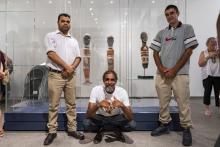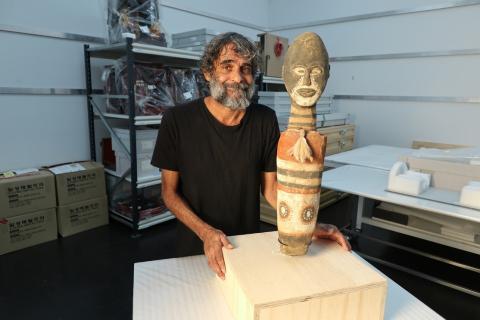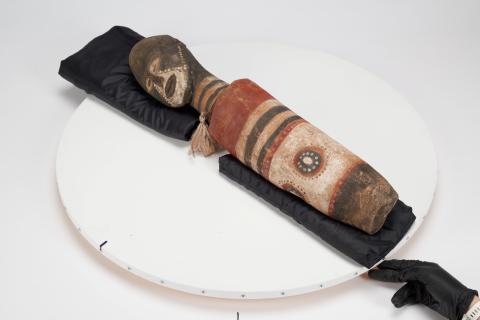Fred Embrey’s sculptures
By Michael Aird, Lindy Allen, Paul Memmott
Fred Embrey Research Project February 2024
Kabi Kabi man Fred Embrey made the wooden sculpture now held by QAGOMA at Manumbar, around 1935. A genre of figurative carving without equal in south-east Queensland, Djan’djari figure 1930s is a rare object of national significance.
The figure is made from a softwood and represents Djan’djari, mischievous little spirits who live in the forest in Kabi Kabi Country. Kabi Kabi men also made shields from softwood that are somewhat similar in size and proportion, with the Djan’dari being 65.5cm in height.
Embrey is remembered as a songman, composer and choreographer, and as a key leader and Miva (man of knowledge) at Cherbourg. He was perhaps amongst the last of the Kabi Kabi men to be initiated, and his deep knowledge of customary Kabi Kabi practices has informed his sculptural work.

Two sculptures (QE11659 and QE11660) by Fred Embrey in 1932–33 at Cherbourg, Queensland Museum, 1 July 2022 / Collection: Queensland Museum, Brisbane / Photograph: Michael Aird
The history of Djan’djari figure appears to be unclear between Embrey’s death in 1939 and 1946, when it is said to have been purchased by a visitor to the Cherbourg Show. It is representative of the genre of sculpture produced by Embrey in the 1930s, with only two other known works: two Djan’djari figures held by the Queensland Museum. Further, it appears to be derived from the figures placed along the pathway between the two rings that formed the bora grounds used for initiation ceremonies.
Fred Embrey’s descendants derive enormous pride from the fact they understand these to be ‘the last traditional carvings from south-east Queensland’.1 They recall their mother, Penny Bond, saying that the figures moved about and made noises in the house.
Yabva’s figures represented the Djan’djari — the ‘little hairy men’ or ‘forest spirits’. Djan’djari are a very important part of our culture and history. Our stories describe them as hairy people who taught our people to make fire, nets, traps and most importantly: teaching us how to share. I was told that these Djan’djaris were ancient people who existed before we were on this land.2
Researchers Lindy Allen (left) and Michael Aird (right) discuss the figures held by the Queensland Museum with Alex Bond (centre), Queensland Museum, Brisbane, 1 July 2022 / Photograph: Simon Elliott © QAGOMA
A collaboration between the University of Queensland and QAGOMA, the Fred Embrey Sculpture Research Project sought to confirm that Embrey made the sculpture acquired by QAGOMA. To this end, a team of researchers positioned the style of the sculpture in its historical context within Aboriginal art traditions, particularly at Cherbourg and south-east Queensland more broadly. Similarities between the Djan’djari held by QAGOMA and two held by Queensland Museum are explored in depth in the resultant research report, available below.
Access the full research report: FRED EMBREY SCULPTURE RESEARCH PROJECT [39pp PDF 18.5mb].
1 & 2. Alex Bond, Ray Kerkhove and Sean Gilligan, The Statesman, the Warrior and the Songman, ICP Aust Inc., Nambour, 2009, p.18.

Djan'djari figure 1930s
- EMBREY, Fred - Creator
Explore the Fred Embrey Research Project

Digital Story Introduction
A CEREMONIAL FIGUREFred Embrey: Songman, sculptor, leader
Read BIOGRAPHYDigital story context and navigation
A CEREMONIAL FIGUREExplore the story








